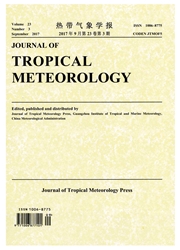

 中文摘要:
中文摘要:
Bilis (0604 ) 是很长时间在土地上支撑了的大热带暴风雨,带奔流的雨。与常规观察数据,雷达数据和红外线的卫星形象, Mesoscale 对流系统(MCS ) 被发现连续地形成并且发展,它引起奔流的雨。然后数字的模拟用 MM5 被进行模仿一个 66-h landfall 以后过程。降水的模仿的分发和紧张匹配观察很好。与模仿的结果, MCS 开发的特征和过程与发现被分析在中国的南方上的夏天季风引起一个 mesoscale 旋涡, mesoscale 集中中心和 mesoscale 集中线的形成的热带消沉和华南海( SCS )的集中,它对发展有利并且 MCS 支撑。一个敏感实验显示 SCS 夏天季风连续地搬运不稳定的精力和水蒸汽,它具有到暴风雨的重要重要性。
 英文摘要:
英文摘要:
Bilis (0604) is a strong tropical storm that sustained over land for a long time, bringing torrential rain. With conventional observation data, radar data and infrared satellite imagery, Mesoscale Convective Systems (MCSs) are found to form and develop successively, which cause torrential rain. Then numerical simulation is conducted using MM5 to simulate a 66-h post-landfall process. The simulated distribution and intensity of precipitation match the observation well. With the simulated result, the characteristics and process of MCS development are analyzed with the finding that the convergence of the tropical depression and South China Sea (SCS) summer monsoon over The south of China causes the formation of a mesoscale vortex, mesoscale convergence center and mesoscale convergence line, which are favorable to the development and sustaining of the MCSs. A sensitivity experiment indicates that the SCS summer monsoon transports unstable energy and water vapor continuously, which is of vital importance to rainstorms.
 同期刊论文项目
同期刊论文项目
 同项目期刊论文
同项目期刊论文
 期刊信息
期刊信息
